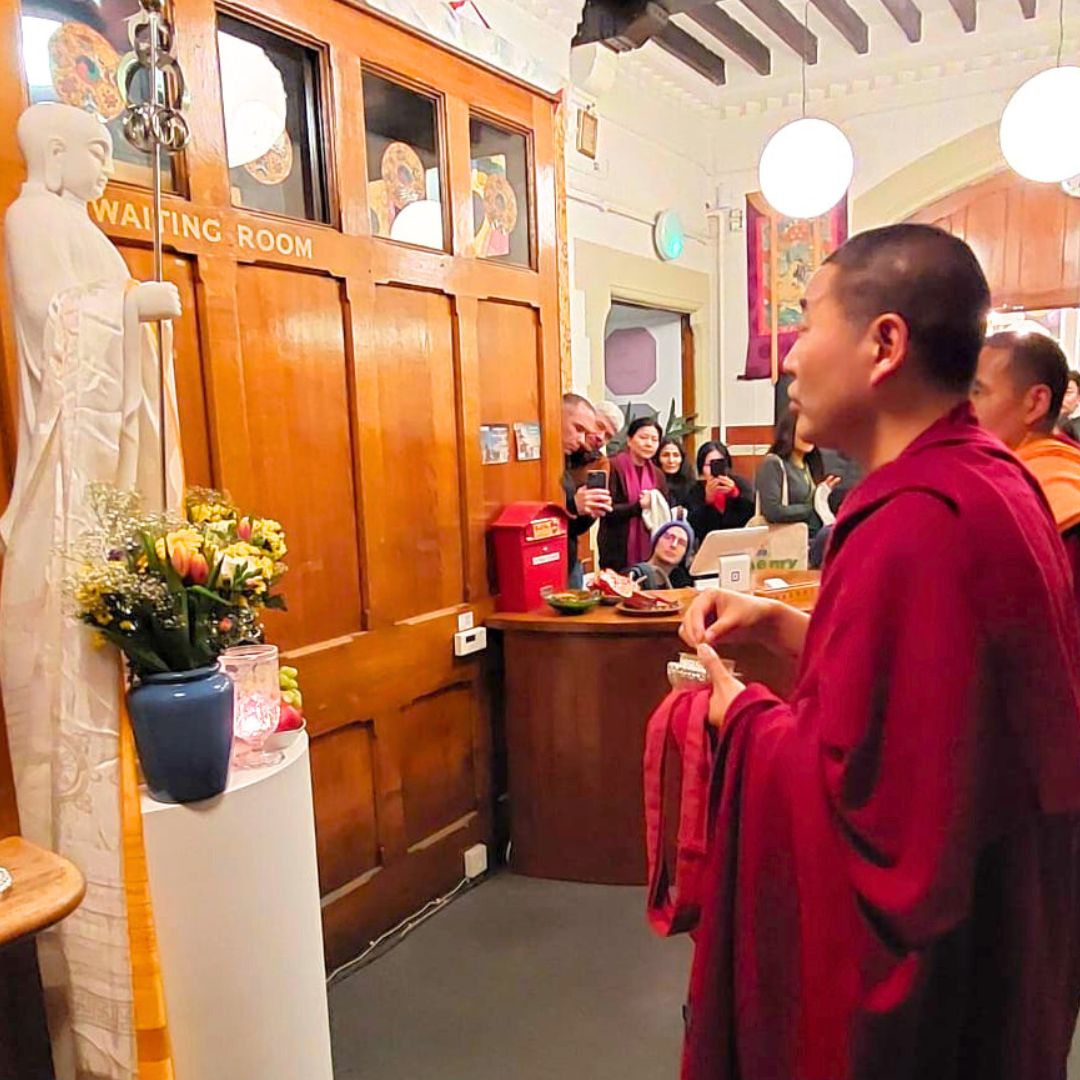A generous benefactor offered to sponsor statues of The Great Bodhisattva Kshitigarbha to FPMT Centres and projects around the world.

On January 2023, Yangten Rinpoche honoured us, coming to Jamyang Buddhist Centre London for a series of teachings.
On this occasion, Yangten Rinpoche consecrated the new statue of the Great Bodhisattva Kshitigarbha.
The statue was shipped in July 2022, at Jamyang London, Jamyang Leeds and Land of Joy.
The statue is carved from a block of solid white marble, and came with two beautiful texts on marble tablets too.
The statue was offered to all the FPMT centres, by a generous benefactor. The offer includes the statue itself and the cost of shipping the statue.
We asked the benefactor what motivated such devotion and generosity. This is what he shared:
“Ksitigarbha was the first Bodhisattva I met when I started to learn Dharma. I recite the Sutra of Ksitigarbha Fundamental Vows almost everyday. In this Sutra, the Buddha entrusted Ksitigarbha to save all beings until the rising of Maitreya. Therefore, he holds the responsibility to protect and promote all Buddha’s teachings. Also, he has very deep connections with beings, especially with the three unfortunate realms. Having the purpose of saving more lives, we started this project about 6 years ago.
In this process, we received a lot of feedback, for example, patients reciting his name/sutra/mantra got cured, suffering people got troubles resolved and obstacles got eliminated, etc. All the feedback encourages us to keep this mission going. We chose stone as the materials because it can last around 1000 years. We believe more people will meet him because of the statue’s presence.”
About The Great Bodhisattva Kshitigarbha

Kshitigarbha is one of the Eight Great Bodhisattvas and often appears alongside Amitabha Buddha in iconography. He is most famous for vowing to save the souls of all beings between Guatama Buddha’s death and the age of Maitreya, including the souls of children who died young and those in Hell. He is a particularly important bodhisattva in China and Japan, where he is turned to as someone who can protect those who are
suffering.
Kshitigarbha’s Name
“Kshitigarbha” can be translated as “Earth Treasury,” “Earth Womb,” or “Essence of the Earth.” Kshitigarbha takes on this name because Shakyamuni named him as the head
of Buddhism on earth. Kshitigarbha also represents the store of dharma on Earth, helping Earth’s residents to attain enlightenment.
Bodhisattva of Hell
The Kshitigarbha Sutra tells the origin story of Kshitigarbha. Before becoming a bodhisattva, Kshitigarbha was a young Brahmin girl in India. Her mother was impious and therefore went to Hell, where she suffered after she died. Her mother’s suffering caused the young Kshitigarbha to swear to save all souls from the torments of Hell. Within the Buddhist tradition, Hell is the lowest of the ten dharma realms, and its inhabitants will be the last to reach enlightenment. Kshitigarbha’s vow not to attain buddhahood until Hell is empty is a great sign of compassion; he delays his own buddhahood until he can lift all souls from suffering to enlightenment. Especially in China, Kshitigarbha (also called Dicang) is considered to be the overlord of Hell, and his name is called when someone is on the verge of death.
Guardian of Children
In Japan, Kshitigarbha is celebrated for his mercy towards all deceased souls. In particular, he is considered to offer compassion and protection for deceased children, including fetuses that were aborted or miscarried. Therefore, in Japanese he is often called Jizo, the protector of children. Statues of him are common around Japan, especially in graveyards. Parents who have lost children sometimes adorn his statues with children’s clothing or toys, hoping that he will protect their children and prevent them from suffering.
Appearance and Iconography
Kshitigarbha is usually depicted as a monk with a shaved head and a halo or nimbus cloud. Most bodhisattvas appear wearing the luxurious robes of royalty. Therefore, it is usually easy to distinguish Kshitigarbha in his simple monk’s robes. In one hand, he carries a staff that he uses to open up the gates of Hell. In the other, he holds a jewel called a cintamani that has the power to light up darkness and grant wishes.
Source: SAM SHEPARDS , JAN 14, 2019
